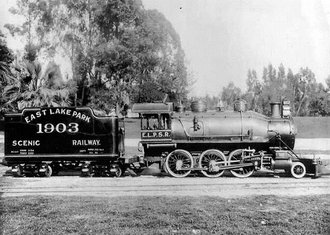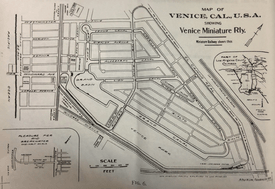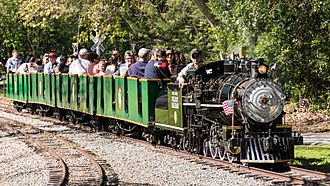Venice Miniature Railway facts for kids
Quick facts for kids Venice Miniature Railway |
|
|---|---|

|
|
| Technical | |
| Line length | 7,500 feet (2,300 m) |
| Track gauge | 18 in (457 mm) |
| Maximum incline | Lion Canal Bridge: 11 % |
The Venice Miniature Railway was a super cool, small train line in Venice, California. It was like a mini version of a real train, built at a 1:3 scale. This fun railway was about 7.5 miles (12 kilometers) long and ran from 1905 to 1925. It was a popular attraction for people visiting Venice, a famous beach town near Los Angeles.
Contents
Where Did the Venice Miniature Railway Go?
The trains started their journey at a special building called the locomotive shed. This was located where Venice Boulevard and Abbot Kinney Boulevard are today. The trains would travel in a big circle, going along Mildred Avenue towards the main business area.
They would then loop around the Post Office and come back along Mildred Avenue. Along the way, the trains crossed several canals, which are like small rivers, on bridges named Riviera and Rialto. Finally, they turned sharply onto Washington Boulevard and used El Camino Real to get back to the starting station and the locomotive shed. It was a scenic trip around Venice!
How Much Did a Ride Cost?
A single trip on the Venice Miniature Railway cost only five cents. That was a really good deal back then! If you rode the train often, you could buy a book of tickets for $1.00. This made each ride even cheaper, costing only two cents. To compare, a one-way trip from Los Angeles to Venice on a bigger train line, the Los Angeles Pacific Railway, cost 15 cents. So, the miniature railway was a very affordable way to see Venice.
The Story of the Venice Miniature Railway

The idea for the Venice Miniature Railway came from Abbot Kinney, who was the person who planned the whole "Venice of America" area. He hired a skilled engineer named John J. Coit to build the miniature railway. Coit was an expert machinist and had already built and run another small train line called the Eastlake Park Scenic Railway in Eastlake Park (now Lincoln Park).
The Trains and Coaches
John J. Coit already owned a small steam locomotive named No. 1903, also known as 3-Spot. This train was about 19 feet (5.8 meters) long and used oil for fuel. It had some cool new features that made it easier to fix and keep running. Even though it worked well on his other railway, it wasn't quite strong enough for the new, bigger railway planned for Venice.
So, Coit ordered two brand-new, more powerful steam locomotives from his old workplace, the Johnson Machine Works. These new trains, named No 1 and No 2, were called 1-Spot and 2-Spot. They were heavier and stronger, weighing about 9,260 pounds (4,200 kilograms) each. They also used oil for fuel and had Coit's special new features.
The boilers, which make the steam for the trains, were built by the Pacific Coast Boiler Works. Each locomotive cost $4,510, which was a lot of money back in 1905! They were painted black with shiny brass parts and silver letters. The only way to tell them apart was the shape of their cab windows: 1-Spot had rectangular windows, while 2-Spot had crescent-shaped tops on its windows. These trains could go pretty fast, up to 30 miles per hour (48 kilometers per hour)!
The railway also had ten passenger coaches, which were like small train cars. They looked fancy, with lion's head decorations on the sides. Five coaches were painted royal blue, and the other five were cherry red. Each coach could seat twelve people. Usually, trains were made up of coaches all the same color.
Disagreements and Closure
After a good start, problems began between Abbot Kinney and John J. Coit. Kinney wanted his two young sons to be involved in the railway. His eight-year-old son, Carleton, was even named "VMR President," and his twelve-year-old son, Innes, was called "Chief Engineer." This made Coit, the real engineer, feel disrespected.
In 1906, Kinney tried to take over the railway from Coit, even though they had a five-year contract. He even forced the railway to close for six months, saying a wooden bridge needed to be replaced with a concrete one.
Things got worse when Kinney tried to take over the railway while Coit was out of town. When Coit returned, he removed some important parts from the locomotives before leaving again. Because Kinney couldn't get these parts made without the original plans, he couldn't run the railway for the rest of the year.
They ended up in court, and while Coit was found not guilty of stealing, Kinney won a civil case against him. Coit had to put the parts back and pay for the costs. After this, Coit left the company and was no longer involved. Sadly, John J. Coit died in a railway accident in 1910 while working on the Panama Canal.
The railway continued to run for another 18 years. However, by the early 1920s, more and more cars were on the roads, and the miniature railway became less popular. Some people even thought it was a bother.
When Abbot Kinney passed away in 1920, his adopted son, Thornton Parillo, kept the railway running. But on February 23, 1925, an official order was given to stop its use. The railway had its last official run in May 1925. After that, local residents worked together to remove the tracks because there was no money set aside to pay for their removal.
Where Are the Trains Now?
The 1-Spot locomotive was found in a scrap yard by a man named Al Smith. He fixed it up and used it for fun rides in San Gabriel and Pico Rivera until the 1950s. After he passed away, it was sold to Don McCoy, who, with his sons, fixed it up again. They used it from 1972 to 1978 at the Whittier Narrows Recreational Area. Today, the 1-Spot is part of the McCoy family's private collection in Southern California.
The 2-Spot locomotive was almost sent to Japan to be scrapped! Luckily, a man named Billy Jones found and rescued it just in time. He bought it, fixed it up, and used it to entertain children on his ranch on Sundays. Today, the 2-Spot is still running and is regularly used at the Billy Jones Wildcat Railroad in Los Gatos, California.
Movies Featuring the Railway
The Venice Miniature Railway was so famous that it even appeared in movies!
- In Harold Lloyd's 1917 movie By the Sad Sea Waves, his character pretends to be a lifeguard to impress ladies. The movie ends with Harold and his new friend, Bebe Daniels, riding off into the sunset on the Venice Miniature Railway.
- In his 1920 movie Number, Please?, Harold Lloyd isn't as lucky. He loses the girl and rides off on the train all by himself.
- The Century Comedy Kids also used the train in their silent movie Speed Boys. In this movie, they run the train because their father is sick. This film was released in Holland as The New Engine Driver.
- Other movies made by Keystone Kid Pictures were also filmed on the railway.
Images for kids












